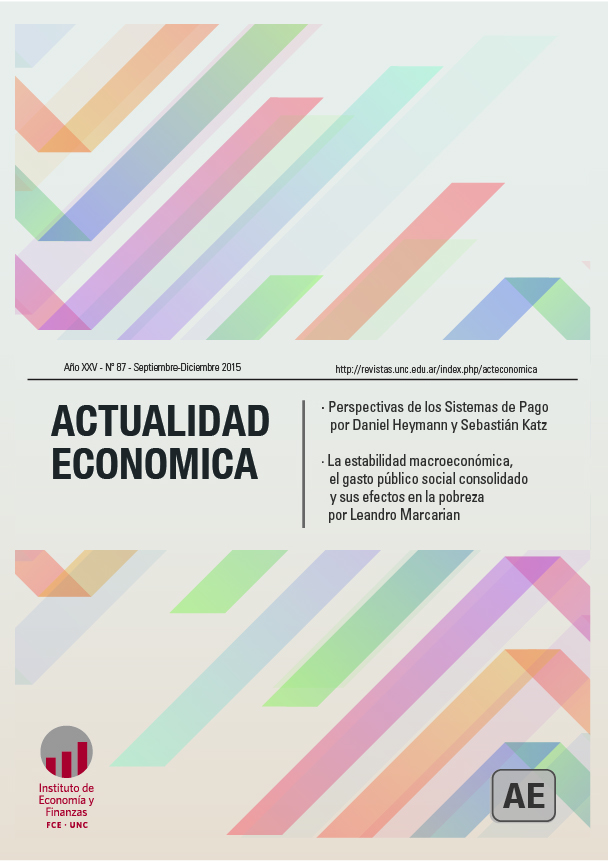Macroeconomic stability, consolidated public social spending and its effects on poverty in 2015
Keywords:
Public Expenditure, Equilibrium, Poverty, Economic Performance IndexAbstract
This paper studies the evolution of the poverty rate in relation to two macroeconomic performance indexes. A first simple index of four variables, called EPI, and another more complex called MRE, composed by the simple average of three sub-indexes, a monetary, a real-fiscal and one that measures the evolution of the external sector. It works under the assumption that the public social expenditure consolidated as a percentage from the GDP has a positive effect on reducing poverty, while macroeconomic instability, measured as a deterioration of the indexes has a negative effect, and the aim is to determine which one of the two dominates. It concludes that the negative effect of macroeconomic instability dominates over the positive effect of the public social expenditure consolidates in 76% of the cases when EPI is used, and a 65% when MRE is used. In turn the chances of success of the indexes, success being understood as the probability that the poverty rate moves in the opposite direction to the indexes, resulted in 74% for the EPI and 68% for the MRE.
Downloads
References
Anoruo E., Braha H., y Ahmad Y. (2002). Purchasing power parity: Evidence from developing countries, The World Bank.
Arakaki A. (2011). “La pobreza en Argentina 1974-2006: Construcción y análisis de la información”, Centro de Estudios sobre Población, Empleo y Desarrollo, Facultad de Ciencias Económicas, Universidad de Buenos Aires.
Basco E., L. D´amato y Garegnani L. (2006). “Crecimiento monetario e inflación: Argentina 1970-2005”, Banco Central de la Republica Argentina.
Capello M., Grión N., Valsagna L. (2013). “Una Argentina competitiva, productiva y federal”, Documento de Trabajo 135, IERAL.
Carrera, C. (2012). “La comunicación del objetivo inflacionario de los Bancos Centrales: Una revisión de casos”, Revista Moneda.
Cherchye, L. (1998). “The measurement of macroecomic performance: Comparison of DEA-based alternatives”, Centrun voor Economische Studiën, Katholieke Universiteit Leuven.
Cristina A. y Barraud A. (2013). “Efectos distributivos del gasto público social en Argentina, con énfasis en educación y salud”, Revista Actualidad Económica, 80.
D´amatoL. y Garegnani L. (2009). “La dinámica de corto plazo de la inflación: estimando una curva de Phillips híbrida neokeynesiana para Argentina (1993-2007)”, Banco Central de la Republica Argentina.
Debrun X. y Kapoor R. (2010). “Fiscal Policy and Macroeconomic Stability: New Evidence and Policy Implications”. Revista de Economía y Estadística, julio.
Friedman M. (1976). Nobel Memorial Lecture: Inflation and Unemployment, Nobel Foundation.
Galí J. (1993). Government size and macroeconomic stability, Columbia University, New York.
Guzman M. y Todesca N., Mira P. (2011). “Deuda Pública Argentina: Del Endeudamiento a la Sostenibilidad”, Ministerio de Economía y Finanzas Públicas de la Republica Argentina.
Haghighi, H., Sameti M. y Isfahani, R. (2012). “The Effect of Macroeconomic Instability on Economic Growth in Iran”, Dept. of Economics, University of Isfahan, Isfahan, Iran.
Jeanne, O. y Rancière, R. (2006), “The Optimal Level of International Reserves for Emerging Market Countries: Formulas and Applications”, Fondo Monetario Internacional
Khramov, V. Ridings Lee, J. (2012). “The Economic Performance Index: an Intuitive Indicator for Assessing a Country’s Economic Performance Dynamics in an Historical Perspective”, Fondo Monetario Interacional.
OECD (1987), World Economic Outlook # 41.
Persia, J. , Toledo, F. y Mira P. (2010). “Consideraciones Críticas Sobre la Tasa Natural de Desempleo a Partir de la Experiencia Argentina”, Ministerio de Economía y Finanzas Públicas de la Republica Argentina.
Phillips, A.W. (1958). “The relation between unemployment and the rate of change of Money wage rates in the United Kindom 1861-1957”. Economica.
Rapoport, M. (2010). “Una revisión histórica de la inflación argentina y sus causas”. Aportes de economía política en el bicentenario de la revolución de mayo, Prometeo, Buenos Aires.
Ravier, A. (2009). “La curva de Phillips de pendiente positiva y la crisis de 2008”, Asociación Argentina de Economía Política.
Rodriguez, C.A. (2000). “On the degree of openness of an open economy”. Universidad del CEMA.
Rodriguez R., y Ruiz O. (2012). “Acumulación de reservas internacionales en países emergentes con tipos de cambio flexibles”. Revista Problemas del Desarrollo.
Solow, R. (1957). Technical Change and the Aggregate Production Function. The MIT Press
Samuelson, P. y Solow, R. (1960). “Analytical Aspects of Anti-Inflation Policy”. American Economic Review, 50(2).
Downloads
Published
Issue
Section
License

This work is licensed under a Creative Commons Attribution-NonCommercial-NoDerivatives 4.0 International License.
Those authors who have published with this journal, accept the following terms:
Authors will conserve their copyright and guarantee the magazine the right of first publication of their work, which will be simultaneously subject to the Creative Commons Attribution-NonCommercial-NoDerivative 4.0 International License that allows third parties to share the work as long as the author and first publication of this magazine are indicated.
Authors may adopt other non-exclusive license agreements to distribute the published version of the work (e.g., deposit it in an institutional telematic archive or publish it in a monographic volume) provided that the initial publication in this journal is indicated.
Authors are allowed and encouraged to disseminate their work through the Internet (e.g., in institutional telematic archives or on their website) before and during the submission process, which may lead to interesting exchanges and increase citations of the published work. (See The effect of open access)









